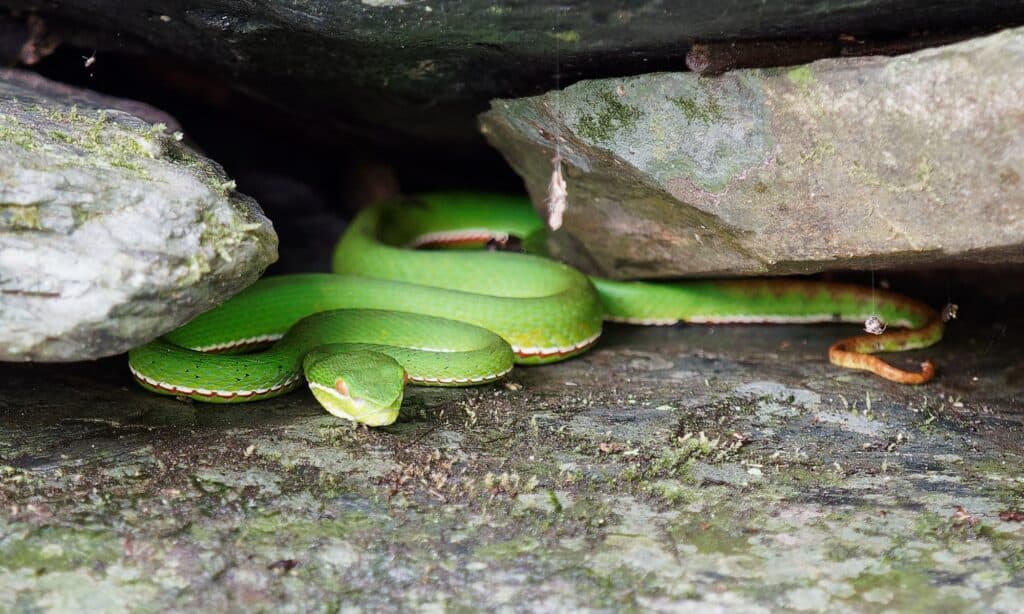Tree Viper (Bamboo Viper)
Trimeresurus stejnegeri
Pit vipers can strike accurately at moving objects less than .5 degrees Farenheit warmer than the background.
Advertisement
Tree Viper (Bamboo Viper) Scientific Classification
- Kingdom
- Animalia
- Phylum
- Chordata
- Class
- Reptilia
- Order
- Squamata
- Family
- Viperidae
- Genus
- Trimeresurus
- Scientific Name
- Trimeresurus stejnegeri
Read our Complete Guide to Classification of Animals.
Tree Viper (Bamboo Viper) Conservation Status
Tree Viper (Bamboo Viper) Facts
- Prey
- Frogs, lizards, small rodents, birds
- Main Prey
- Frogs, lizards
- Name Of Young
- Neonate, snakelet
- Group Behavior
- Solitary except during mating season
- Fun Fact
- Pit vipers can strike accurately at moving objects less than .5 degrees Farenheit warmer than the background.
- Estimated Population Size
- Unknown but believed stable
- Biggest Threat
- Habitat destruction
- Most Distinctive Feature
- Red eyes and dorso-linear stripe
- Other Name(s)
- Stejneger's pit viper, Chinese pit viper, Chinese green tree viper, bamboo viper, Chinese bamboo pitviper, bamboo viper, and Chinese tree viper.
- Gestation Period
- Probably 6-7 months
- Lifestyle
- Nocturnal
- Favorite Food
- Frogs, lizards, small rodents, birds
- Common Name
- Stejneger's Pit Viper
- Special Features
- Triangular head, red eyes, dorso-linear stripe.
- Location
- Southern china, Nepal, Northeastern India, Taiwan, Laos, Vietnam
- Group
- den, nest, pit, bed, knot
Tree Viper (Bamboo Viper) Physical Characteristics
- Color
- Yellow
- Green
- Skin Type
- Scales
- Length
- Up to 30 inches
- Venomous
- Yes
- Aggression
- Medium
View all of the Tree Viper (Bamboo Viper) images!
Tree vipers are venomous pit vipers that live in Southeast Asia including southern China, Northeast India, Nepal, Myanmar, Laos, Vietnam, and Taiwan.
The venomous tree viper goes by many names, depending upon its location. The most common are Stejneger’s pit viper, Stejneger’s tree viper, bamboo viper, Chinese green tree viper, Chinese pit viper, Chinese bamboo pit viper, and Chinese tree viper.
Incredible Tree Viper (Bamboo Viper) Facts
- Tree viper bites can be deadly, but if treated most victims survive with little problem.
- 20+ species are called tree vipers or bamboo vipers.
- They’re often confused with the harmless greater green snake.
- Stejneger’s tree viper only grows to about 30 inches in length.
Tree Viper (Bamboo Viper) Scientific Name and Classification
Tree vipers are pitvipers in the Crotalinae subfamily of Viperidae. Trimeresurus is a compound word formed from Greek and Latin. The first part, Trimeres is Greek and means “of three parts.” The second part, -urus is Latin and refers to the tail. Many of the Tremeresurus genus snakes have tails of a different color, and all have prehensile tails.
Their specific name, stejnegeri, honors Leonhard Stejneger, a herpetologist who worked at the Smithsonian Institution for over 60 years. There are two subspecies of tree viper (bamboo viper), T. s. stejnegeri and T. s. chenbihuii; the nominate subspecies is more widespread, while T. s. chenbihuii is isolated to Hainan Island’s Mount Diaoluo and Wuzhi Mountain.
These snakes have many common names, which include Stejneger’s pit viper, bamboo viper, Chinese green tree viper, Chinese pit viper, Chinese bamboo pitviper, and Chinese tree viper. There are certainly more that are likely local names given by the people who live near it.
Types of Tree Viper (Bamboo Viper)
Common names can get very confusing very quickly. This is yet another reason for the use of scientific names. There are at least a half dozen snakes that people commonly refer to as bamboo or tree vipers. It’s because there are several dozen vipers that live in trees, so a few of them were bound to be called tree vipers or bamboo vipers. Most of them are in the Trimeresurus genus, but a few are Atheris.
Atheris
- Rough-scaled tree viper (A. hispida)
- Tree viper (A. squamigera)
Craspadocephalus
- Common bamboo viper (C. gramineus)
Trimeresurus
Many of the 40+ species in Trimeresurus carry the “green tree viper” moniker in some form. Here are a few:
- Chinese bamboo viper (T. stejnegeri)
- Red-tailed bamboo pit viper (T. erythrurus)
- Nicobar bamboo pit viper (T. labialis)
- McGregor’s tree viper (T. mcgregori)
- Central Nicobar bamboo pit viper (T. mutabilis)
Tree Viper (Bamboo Viper) Appearance
This species, like most arboreal snakes, is light-bodied and fairly small. They only reach about 30 inches long, which includes a prehensile tail that often measures 5.7 inches long. Tree vipers (bamboo vipers) are pitvipers with a typically triangular head, a noticeable heat-sensing pit between the nostril and eye, and red eyes with vertical pupils. Their retractable fangs are nature’s version of a hypodermic needle and they’re able to inject venom deeply into a victim.
A Tree viper’s (bamboo viper’s) dorsal color can be bright to dark green; the ventral is pale green to whitish. A stripe separates the dorsal and ventral colors and runs the length of its body. In this snake, the stripe starts near the snout and runs between the lip and eye, all the way down the length of the body. The stripe is one way to tell males from females because males have stripes that are typically bicolored with red or brown and white. In females, it can be bicolored but is more often white. Juveniles have brightly colored tails that they use for luring prey. Colors and patterns can vary depending upon their habitat.

This species hides in bushes and crevices when it isn’t in the trees.
©iStock.com/yanjf
Tree viper (bamboo viper) Look Alike
Tree vipers (bamboo vipers) are sometimes confused with the greater green snake, a nonvenomous colubrid native to many of the same areas. One very large difference is the head shape and eyes. The greater green snake (Ptyas major) has a small head with large gold or green eyes and round pupils, whereas the tree viper (bamboo viper) has a big triangular head with red eyes and vertical pupils.
In all cases, if you are not 150% certain of your species identification, do not handle the snake.
Tree Viper (Bamboo Viper) Behavior
These snakes are generally slow-moving and arboreal; in fact, many arboreal snakes move slowly so they don’t fall out of their treetop home. Tree vipers are nocturnal and more active at night and sometimes roost in bushes by day.
They aren’t aggressive in a traditional sense, but if cornered, tree vipers stand their ground and do not hesitate to bite. Although this is a trait shared by many arboreal snakes, these snakes tend to strike at anything warm that moves nearby. This species sits in one position, sometimes for many hours or days, to ambush its prey when it wanders too close. Their sense of smell is excellent, and they use Jacobson’s organ and their tongue to help track down prey when the ambient temperature doesn’t favor their heat-sensing pits.
Venom: How Dangerous is the Tree Viper (Bamboo Viper)
While fatalities are rare with tree vipers (bamboo vipers), they can occur. Their venom is primarily made up of hemotoxins that attack the blood. They don’t always envenomate when they bite, but when they do the symptoms begin with local pain that quickly becomes intense, requiring very strong painkillers. Victims of tree viper (bamboo viper) snakebites describe the pain as if they had been branded with a hot iron. It does not subside until about 24 hours after being bitten.
Other symptoms include:
- Swelling around the bite.
- Tissue necrosis of varying severity, depending on the bite depth and quantity of venom injected.
- Kidney dysfunction.
- Nausea.
- Dizziness.
Tree Viper (Bamboo Viper) Habitat
Found in Northeast India, Nepal, Myanmar, Laos, Taiwan, Vietnam, and Southern China, the tree viper (bamboo viper) generally favors forested areas along trails, streams, or culverts. Historically, it avoided human-made habitats in favor of forested areas. However, in recent years it is increasingly found hanging around light poles and other areas close to homes and towns.
The tree viper (bamboo viper) inhabits forests at altitudes from sea level to 3,200 feet. Its coloration allows it to blend seamlessly into its habitat and isn’t always easy to spot.
Tree Viper (Bamboo Viper) Diet
Like many snakes, the tree viper (bamboo viper) eats a variety of small prey and frogs appear to be its primary source of food. However, it also takes rodents, birds, and lizards.
Tree Viper (Bamboo Viper) Predators, Threats, Conservation, and Population
According to the IUCN Redlist of Threatened Species, the tree viper (bamboo viper) is a species of Least Concern because it is widespread and probably isn’t declining quickly enough to be considered in a higher category. It’s presumed to have a large population, but no actual count is available.
It doesn’t seem to have any significant threats, except in some areas its numbers are decreasing in response to habitat changes.
Tree Viper (Bamboo Viper) Reproduction, Babies, and Lifespan
Its breeding behavior is relatively unknown, but females give birth to litters of 3-10 babies that look like miniatures of their parents. The babies are small and only measure about 4.5 inches long when they’re born.
Next Up
- Vine snakes of several species are native to the same areas where tree vipers live.
- The dragon snake is also known as the Spiny bush viper. It’s native to areas in central Africa
- Green tree pythons are native to some parts of Southeast Asia and Australia.
Tree Viper (Bamboo Viper) FAQs (Frequently Asked Questions)
Is the tree viper (bamboo viper) venomous?
Yes! Fatalities are rare, but anyone bit by this snake needs immediate medical care.
What does the tree viper (bamboo viper) eat?
They seem to prefer frogs; however, they’ll also eat birds, lizards, and small rodents.
Are tree vipers (bamboo vipers) aggressive?
Not traditionally, however, like other arboreal snakes, they tend to strike at anything that moves.
How do tree vipers (bamboo vipers) hunt?
They hunt by ambush. You could almost say that most snakes are lazy predators. This species hangs from tree branches and light poles, waiting for prey to wander close enough to grab.
Where do tree vipers (bamboo vipers) live?
In the forests of Southeast Asia! These arboreal snakes live at elevations up to about 3,200 feet.
Thank you for reading! Have some feedback for us? Contact the AZ Animals editorial team.
Sources
- “Trimeresurus.” Merriam-Webster's Unabridged Dictionary, Merriam-Webster, https://unabridged.merriam-webster.com/unabridged/Trimeresurus. Accessed 15 Aug. 2022.“Trimeresurus.” Merriam-Webster's Unabridged Dictionary, Merriam-Webster, https://unabridged.merriam-webster.com/unabridged/Trimeresurus. Accessed 15 Aug. 2022. / Accessed August 15, 2022
- Trimeresurus stejnegeri | Reptarium Reptile Database / Accessed August 15, 2022
- Hong Kong Snake ID / Accessed August 15, 2022
- Liao-Chun Chiang Wei-Jen Tsai Po-Yu Liu Cheng-Hsuan Ho Hung-Yuan Su Chih-Sheng Lai Kuo-Lung Lai Wen-Loung Lin Chi-Hsin Lee Yi-Yuan Yang Uyen Vy Doan Tri Maharani Yan-Chiao Mao. (2020). Envenomation by Trimeresurus stejnegeristejnegeri : clinical manifestations, treatmentand associated factors for wound necrosis. Journal of Venomous, 14. / Published September 18, 2020 / Accessed August 15, 2022
- Stejneger's Pit Viper / Published September 1, 2011 / Accessed August 15, 2022


















